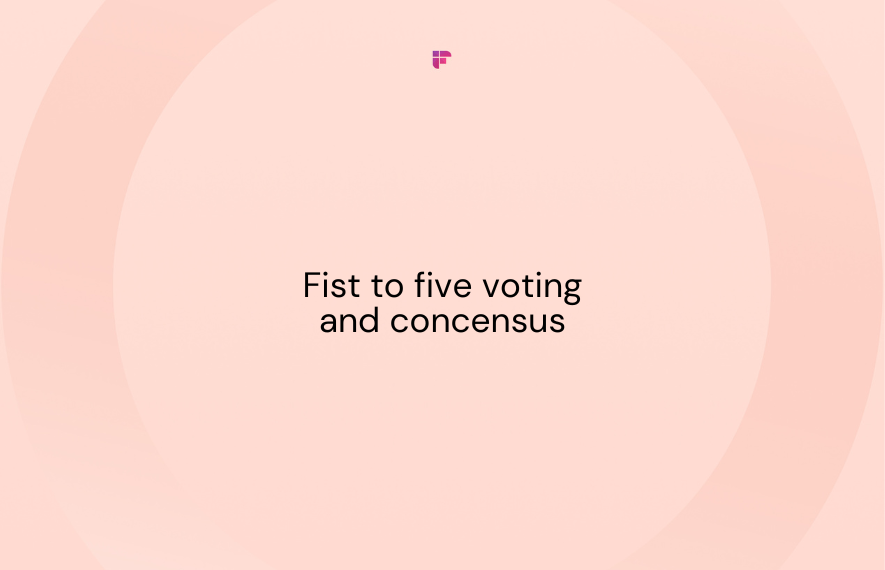Yes or no—is that how your business makes critical decisions? If yes, it needs to stop.
That's because it is difficult to reach a consensus with binary voting, especially when multiple stakeholders with varying opinions and perspectives are involved in the decision-making process.
Time to embrace Fist to Five voting, which lets you effectively collect everyone's opinion and come up with the right decisions in a reasonable amount of time.
This blog will give you all the details on the Fist to Five voting—from what it is to how it works and its advantages and disadvantages. So, read on!
What is Fist to Five?

Fist to Five is an effective technique used by global leaders to understand the overall sentiments of a group.
It works in simple terms where the facilitator presents a proposal, idea, or decision to the group, and each member expresses their level of agreement or support using a simple hand gesture—holding up the number of fingers, ranging from a fist (indicating strong disagreement) to five fingers (indicating enthusiastic agreement).
By following the Fist to Five strategy, you can give everyone a voice and the opportunity to express their opinion in a non-threatening and respectful way.

Fist to Five voting process
The Fist to Five voting process begins with the facilitator presenting the proposal or idea.
Each participant then decides on a score between one and five, representing their level of agreement or support for the proposal.
When everyone is ready, participants simultaneously hold up the corresponding number of fingers to indicate their score:
Now, the facilitator tallies the scores and shares the results with the group.
The group can then discuss the results and use them to guide further discussion or reach a decision.
How does Fist to Five work in meetings?
The Fist to Five consensus was first introduced in the 1990s and has gained popularity since it provides a tangible way of quickly reaching a collective decision.
You can follow these 5 simple steps to effectively implement this technique in the next meeting you lead.
Step 1: Present the Proposal
Present the proposal, idea, or question to the group. For example, the proposal is to implement a work-from-home policy for all employees.
Step 2: Call for Vote
Now, as the facilitator, ask the participants to rate their level of agreement or support for the proposal using a scale of 1 to 5, with hand gestures.
Team member 1: Four
Team member 2: Three
Team member 3: Five
Team member 4: Two

Step 3: Count the Votes
Once you’ve all the responses, quickly tally the responses and get a sense of the overall support or opposition for the proposal.
In the above case, the team agrees to the proposal, and you can use this information to make decisions and identify areas of concern or disagreement.
Step 4: Give an open mic
As the fourth step in your Fist to Five voting, give your peers an open space to speak about their concerns or opinions. In the above example, here's what the team members may have to say about your proposal on implementing a work-from-home policy for all employees:
Team member 1 (who voted four): I think it's a good idea, but must ensure all employees can access the technology and resources needed to work from home.
Team member 2 (who voted three): I agree that we should explore the idea, but we must consider the impact on team collaboration and productivity.
Team member 3 (who voted five): I've been waiting for this proposal for years. I think it's a great opportunity to improve work-life balance and employee satisfaction.
Team member 4 (who voted two): I don't think it's a good idea. I prefer to work in an office environment and feel I wouldn't be as productive at home.
At this stage, you’re sparking discussions and might have to take notes to evaluate them further before deciding.
💡 Fireflies Tip
Let Fireflies help! Fireflies is an AI Notetaker app that automatically transcribes, summarizes, , and analyzes conversations, enabling you to actively participate in discussions.
Step 5: Make the decision
After the voting and discussions are complete, it’s time to make the decision.
While 100% consensus isn’t always possible, you must reconsider the proposal even if more than half of the crowd chooses for less than three fingers.
You and your team will have to rework the proposal based on the discussion and repeat the processes until you reach a consensus on what will work best for the business.
Fist to Five is a voting technique that becomes easier and more effective with practice. So, implement and familiarize yourself and your team with it in upcoming meetings.
Advantages and disadvantages of Fist to Five
Advantages of Fist to Five
Here are seven major advantages of Fist to Five decision-making:
- Fast and easy
- Highly flexible
- Encourages clear communication and critical thinking
- Promotes collaboration and discussion
- Prevents groupthink
- Fosters a positive team culture
- Promotes consensus
1. Fast and easy
Have you ever given a 5-star to a restaurant on Google?
Fist to Five also works on similar principles, where you can simply share your opinion by raising your hand (instead of clicking the stars).
It does not require additional training, experience, or tools, making it a simple and fastest feedback-gathering technique in a meeting.
2. Highly flexible
Fist to Five voting can be easily adapted to different situations, making it a versatile tool for making decisions.
3. Encourages clear communication and critical thinking
Sometimes, the proposal made by your boss or colleague might not appeal to your wits, but you’re not ready to dismiss it completely, either. The Fist to Five technique allows you to express your dissatisfaction in the right terms without putting you in a fix of picking sides.
It ensures your team members clearly understand and discuss each other's level of agreement or disagreement, avoiding confusion or ambiguity and leading to more informed decisions.
4. Promotes collaboration and discussion
Fist to Five triggers constructive and informative discussions about the reasons behind each person's opinion, resulting in a deeper understanding of the issues.
5. Prevents groupthink
Do you agree with the impact peer pressure has on making decisions? Just because Ross voted yes, Joy also gave the same answer even when he couldn’t entirely agree.
The Fist to Five technique prevents this groupthink and allows everyone to express their views.
6. Fosters a positive team culture
The Fist to Five decision-making approach creates an open, collaborative environment that encourages teamwork and respect for different perspectives.
7. Promotes consensus
Fist to Five voting promotes consensus-building as team members can adjust their level of agreement or disagreement based on the feedback of others.
While Fist to Five voting can be useful in many situations, it's important to consider its limitations and ensure it's suitable for the specific context and goal.
You should know a few disadvantages of Fist to Five voting before implementing it.
Disadvantages of Fist to Five voting
- Lack of anonymity
- Too simple
- Limited options
- May not work for larger groups
1. Lack of anonymity
Fist to Five voting is not anonymous. This may make some team members hesitant to express their true opinion, particularly if they fear retaliation or negative feedback.
2. Too simple
While Fist to Five voting can be useful in many situations, its simplistic approach may not be appropriate for more complex decision-making processes.
It may not be suitable when the stakes are high, such as when significant resources or investments are at risk.
3. Limited options
The Fist to Five scale only provides a limited range of options, which may not accurately capture the complexity of some decisions.
4. May not work for larger groups
In larger groups, Fist to Five voting may become unwieldy or time-consuming, making it difficult to reach a consensus.
Final thoughts
The straightforward and intuitive approach to decision-making makes Fist to Five technique a real game-changer for team meetings.
By holding up a certain number of fingers, you can quickly and easily gauge the level of agreement and support for any proposal or decision.
Fist to Five voting method is like a visual high-five that gets everyone on the same page!
So, the next time you're stuck in a meeting, staring at a proposal, and wondering what everyone else is thinking, give Fist to Five a try. Who knows, you might just find yourself high-fiving your team and celebrating a job well done!









